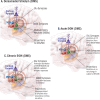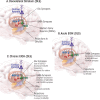Mechanisms of Neuroplasticity and Ethanol's Effects on Plasticity in the Striatum and Bed Nucleus of the Stria Terminalis
- PMID: 26259092
- PMCID: PMC4476598
Mechanisms of Neuroplasticity and Ethanol's Effects on Plasticity in the Striatum and Bed Nucleus of the Stria Terminalis
Abstract
Long-lasting changes in synaptic function (i.e., synaptic plasticity) have long been thought to contribute to information storage in the nervous system. Although synaptic plasticity mainly has adaptive functions that allow the organism to function in complex environments, it is now clear that certain events or exposure to various substances can produce plasticity that has negative consequences for organisms. Exposure to drugs of abuse, in particular ethanol, is a life experience that can activate or alter synaptic plasticity, often resulting in increased drug seeking and taking and in many cases addiction.Two brain regions subject to alcohol's effects on synaptic plasticity are the striatum and bed nucleus of the stria terminalis (BNST), both of which have key roles in alcohol's actions and control of intake. The specific effects depend on both the brain region analyzed (e.g., specific subregions of the striatum and BNST) and the duration of ethanol exposure (i.e., acute vs. chronic). Plastic changes in synaptic transmission in these two brain regions following prolonged ethanol exposure are thought to contribute to excessive alcohol drinking and relapse to drinking. Understanding the mechanisms underlying this plasticity may lead to new therapies for treatment of these and other aspects of alcohol use disorder.
Figures


Similar articles
-
Ethanol-induced conditioned place preference and aversion differentially alter plasticity in the bed nucleus of stria terminalis.Neuropsychopharmacology. 2019 Oct;44(11):1843-1854. doi: 10.1038/s41386-019-0349-0. Epub 2019 Feb 22. Neuropsychopharmacology. 2019. PMID: 30795004 Free PMC article.
-
Binge ethanol drinking associated with sex-dependent plasticity of neurons in the insula that project to the bed nucleus of the stria terminalis.Neuropharmacology. 2021 Sep 15;196:108695. doi: 10.1016/j.neuropharm.2021.108695. Epub 2021 Jul 4. Neuropharmacology. 2021. PMID: 34233202 Free PMC article.
-
Synaptic Plasticity in the Bed Nucleus of the Stria Terminalis: Underlying Mechanisms and Potential Ramifications for Reinstatement of Drug- and Alcohol-Seeking Behaviors.ACS Chem Neurosci. 2018 Sep 19;9(9):2173-2187. doi: 10.1021/acschemneuro.8b00169. Epub 2018 Jun 13. ACS Chem Neurosci. 2018. PMID: 29851347 Free PMC article.
-
Ethanol effects on N-methyl-D-aspartate receptors in the bed nucleus of the stria terminalis.Cold Spring Harb Perspect Med. 2013 Apr 1;3(4):a012161. doi: 10.1101/cshperspect.a012161. Cold Spring Harb Perspect Med. 2013. PMID: 23426579 Free PMC article. Review.
-
Modulation of glutamatergic synaptic transmission in the bed nucleus of the stria terminalis.Prog Neuropsychopharmacol Biol Psychiatry. 2009 Nov 13;33(8):1329-35. doi: 10.1016/j.pnpbp.2009.05.022. Epub 2009 Jun 11. Prog Neuropsychopharmacol Biol Psychiatry. 2009. PMID: 19524008 Free PMC article. Review.
Cited by
-
Alcohol induces input-specific aberrant synaptic plasticity in the rat dorsomedial striatum.Neuropharmacology. 2017 Sep 1;123:46-54. doi: 10.1016/j.neuropharm.2017.05.014. Epub 2017 May 17. Neuropharmacology. 2017. PMID: 28526611 Free PMC article.
-
The ethanol metabolite acetic acid activates mouse nucleus accumbens shell medium spiny neurons.J Neurophysiol. 2021 Feb 1;125(2):620-627. doi: 10.1152/jn.00659.2020. Epub 2021 Jan 6. J Neurophysiol. 2021. PMID: 33405999 Free PMC article.
-
Synaptic Mechanisms of Ethanol Tolerance and Neuroplasticity: Insights from Invertebrate Models.Int J Mol Sci. 2024 Jun 21;25(13):6838. doi: 10.3390/ijms25136838. Int J Mol Sci. 2024. PMID: 38999947 Free PMC article. Review.
-
Ethanol-induced conditioned place preference and aversion differentially alter plasticity in the bed nucleus of stria terminalis.Neuropsychopharmacology. 2019 Oct;44(11):1843-1854. doi: 10.1038/s41386-019-0349-0. Epub 2019 Feb 22. Neuropsychopharmacology. 2019. PMID: 30795004 Free PMC article.
-
Chronic ethanol exposure increases inhibition of optically targeted phasic dopamine release in the nucleus accumbens core and medial shell ex vivo.Mol Cell Neurosci. 2017 Dec;85:93-104. doi: 10.1016/j.mcn.2017.09.007. Epub 2017 Sep 20. Mol Cell Neurosci. 2017. PMID: 28942046 Free PMC article.

